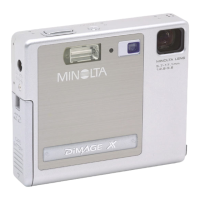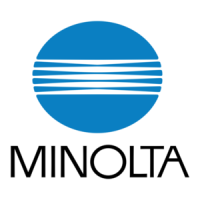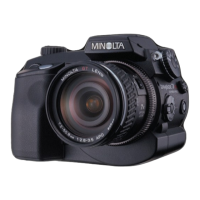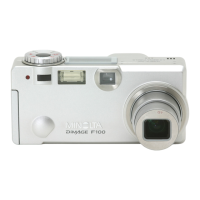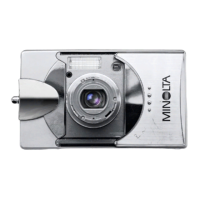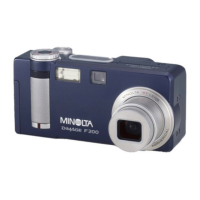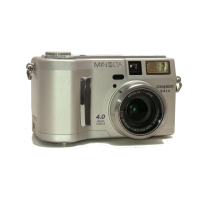Do you have a question about the Minolta Dimage 5 and is the answer not in the manual?
Identifies and illustrates the main physical components of the camera body.
Explains the camera shake warning and how to prevent it.
Step-by-step guide for attaching the camera strap.
Instructions on how to safely remove the lens cap.
Details on mounting and using the lens hood.
Procedure for correctly inserting batteries into the camera.
Steps for inserting the CompactFlash memory card.
Instructions on camera grip and turning the camera on.
Basic steps for composing and capturing an image.
How to use the camera's built-in flash.
Information on the effective range of the automatic flash.
Viewing and deleting captured images in quick view.
Procedure for replacing the camera's batteries.
Explains the meaning of battery status icons.
Describes the camera's automatic power-saving feature.
Information on using optional AC adapters and battery packs.
Guidelines for inserting and changing the CompactFlash card.
How to set the camera for fully automatic shooting.
Details on the electronic viewfinder and LCD monitor displays.
Covers focus frame, focus lock, and focus signals.
Detailed explanation of the focus lock function.
Explains the meaning of focus confirmation signals.
Addresses challenges and solutions for difficult focusing scenarios.
How to adjust display settings during recording.
How to access and navigate captured images in quick view.
Information shown during quick view playback.
Procedure for deleting images from quick view.
Explains exposure value (Ev) and stops in photography.
How the pro-auto button resets camera settings.
Using scene modes to optimize camera performance.
How to use the function dial to change camera settings.
Selecting image resolution and compression settings.
How the frame counter indicates remaining shots.
Details on RAW, Super fine, Fine, Standard, and Economy quality.
Specifics on large file sizes and processing for these qualities.
Table showing file sizes and card storage estimates.
Overview of Program, Aperture, Shutter, and Manual exposure modes.
Explanation of the automatic Program exposure mode.
How to adjust exposure combinations in Program mode.
Setting aperture and letting the camera choose shutter speed.
Setting shutter speed and letting the camera choose aperture.
Full manual control over shutter speed and aperture.
Controls for single shot, continuous, self-timer, bracketing, interval.
Capturing multiple shots by holding the shutter button.
Using the self-timer for delayed shots.
Taking multiple shots with slight exposure variations.
Detailed steps for setting up exposure bracketing.
Bracketing contrast or color saturation.
Important considerations when using bracketing.
Capturing images at set time intervals.
Adjusting white balance for accurate color reproduction.
How the camera automatically sets white balance.
Using pre-defined white balance settings.
Calibrating white balance to specific lighting conditions.
Setting camera sensitivity for different light levels.
Adjusting image characteristics like exposure, contrast, saturation.
Adjusting exposure for lighter or darker images.
Adjusting scene contrast levels.
Adjusting the intensity of colors in the image.
Selecting and moving focus areas for precise focusing.
Moving the focus point freely within the image.
Explains Single AF and Continuous AF modes.
How to take close-up photographs of small objects.
Doubling the lens magnification digitally.
How to manually adjust focus for sharp images.
Using magnification to aid manual focusing.
Information about the electronic viewfinder.
Adjusting the viewfinder for user's eyesight.
Enhancing low-light images on displays.
How to lock focus and/or exposure using the AF/AEL button.
Explains multi-segment, center-weighted, and spot metering.
Details ADI and pre-flash TTL metering methods.
Covers Fill-flash, Red-eye reduction, and Rear flash sync.
How to reduce red-eye effect in flash photos.
Using flash at the end of long exposures for motion effects.
Adjusting flash output for desired lighting ratios.
Table showing flash range based on ISO and lens position.
How to mount external flash units.
Guide to accessing and using the recording mode menus.
Explains AF, Metering, Flash modes, and Flash compensation settings.
Covers memory, exposure bracket, interval, and AF/AE lock settings.
Settings for sharpness, color mode, data imprinting, and instant playback.
How to save and recall custom camera settings.
Adjusting image sharpness and color vs. black and white.
Adding date, time, or text to images.
Using the on-screen keyboard for text input.
Configuring how images are displayed after capture.
How to record short digital video clips.
Table showing functions available or disabled during movie recording.
Instructions for long exposures and remote shutter control.
How to view still images and movie clips using the controller.
Procedure for deleting images from playback mode.
How images and movies are displayed in playback.
Understanding and using the image histogram.
How to adjust display settings for playback.
Cycling through full, image only, and index playback formats.
Zooming into images for closer examination.
Table showing magnification steps for different image sizes.
Guide to accessing and navigating playback mode menus.
Details on delete, lock, index format, slide show, DPOF, print, copy.
Options for deleting single, multiple, or all images.
Protecting images from accidental deletion.
Setting the number of images shown in index view.
How to set up and control automatic image display.
Settings for duration, repeat, and playback selection.
Explains Digital Print Order Format for printing.
How to set up a print order for photofinishing services.
Creating an index print of all folder images.
Deleting existing DPOF print files.
Copying images between CompactFlash cards.
Interface for selecting multiple images for operations.
Connecting the camera to a TV for image viewing.
Guide to accessing and navigating setup menus.
Settings for brightness, format, power save, beep, and language.
Settings for file numbering, folders, and new folder creation.
Options for reset, EVF auto switch, date/time, and video output.
System requirements for connecting the camera to a PC or Mac.
Step-by-step guides for connecting to Windows and Mac operating systems.
Structure of folders and files on the CompactFlash card.
Safe procedures for disconnecting the camera from a computer.
Chart showing equivalent focal lengths in 35mm photography.
Fundamental principles of photography like aperture and shutter.
Overview of compatible camera accessories.
Common problems, causes, and solutions for camera operation.
Guidelines for cleaning, storing, and handling the camera.
Pre-journey checks, contact info, and product certifications.
Detailed technical data and specifications of the camera.
Information and recommendations regarding battery usage.
Identifies and illustrates the main physical components of the camera body.
Explains the camera shake warning and how to prevent it.
Step-by-step guide for attaching the camera strap.
Instructions on how to safely remove the lens cap.
Details on mounting and using the lens hood.
Procedure for correctly inserting batteries into the camera.
Steps for inserting the CompactFlash memory card.
Instructions on camera grip and turning the camera on.
Basic steps for composing and capturing an image.
How to use the camera's built-in flash.
Information on the effective range of the automatic flash.
Viewing and deleting captured images in quick view.
Procedure for replacing the camera's batteries.
Explains the meaning of battery status icons.
Describes the camera's automatic power-saving feature.
Information on using optional AC adapters and battery packs.
Guidelines for inserting and changing the CompactFlash card.
How to set the camera for fully automatic shooting.
Details on the electronic viewfinder and LCD monitor displays.
Covers focus frame, focus lock, and focus signals.
Detailed explanation of the focus lock function.
Explains the meaning of focus confirmation signals.
Addresses challenges and solutions for difficult focusing scenarios.
How to adjust display settings during recording.
How to access and navigate captured images in quick view.
Information shown during quick view playback.
Procedure for deleting images from quick view.
Explains exposure value (Ev) and stops in photography.
How the pro-auto button resets camera settings.
Using scene modes to optimize camera performance.
How to use the function dial to change camera settings.
Selecting image resolution and compression settings.
How the frame counter indicates remaining shots.
Details on RAW, Super fine, Fine, Standard, and Economy quality.
Specifics on large file sizes and processing for these qualities.
Table showing file sizes and card storage estimates.
Overview of Program, Aperture, Shutter, and Manual exposure modes.
Explanation of the automatic Program exposure mode.
How to adjust exposure combinations in Program mode.
Setting aperture and letting the camera choose shutter speed.
Setting shutter speed and letting the camera choose aperture.
Full manual control over shutter speed and aperture.
Controls for single shot, continuous, self-timer, bracketing, interval.
Capturing multiple shots by holding the shutter button.
Using the self-timer for delayed shots.
Taking multiple shots with slight exposure variations.
Detailed steps for setting up exposure bracketing.
Bracketing contrast or color saturation.
Important considerations when using bracketing.
Capturing images at set time intervals.
Adjusting white balance for accurate color reproduction.
How the camera automatically sets white balance.
Using pre-defined white balance settings.
Calibrating white balance to specific lighting conditions.
Setting camera sensitivity for different light levels.
Adjusting image characteristics like exposure, contrast, saturation.
Adjusting exposure for lighter or darker images.
Adjusting scene contrast levels.
Adjusting the intensity of colors in the image.
Selecting and moving focus areas for precise focusing.
Moving the focus point freely within the image.
Explains Single AF and Continuous AF modes.
How to take close-up photographs of small objects.
Doubling the lens magnification digitally.
How to manually adjust focus for sharp images.
Using magnification to aid manual focusing.
Information about the electronic viewfinder.
Adjusting the viewfinder for user's eyesight.
Enhancing low-light images on displays.
How to lock focus and/or exposure using the AF/AEL button.
Explains multi-segment, center-weighted, and spot metering.
Details ADI and pre-flash TTL metering methods.
Covers Fill-flash, Red-eye reduction, and Rear flash sync.
How to reduce red-eye effect in flash photos.
Using flash at the end of long exposures for motion effects.
Adjusting flash output for desired lighting ratios.
Table showing flash range based on ISO and lens position.
How to mount external flash units.
Guide to accessing and using the recording mode menus.
Explains AF, Metering, Flash modes, and Flash compensation settings.
Covers memory, exposure bracket, interval, and AF/AE lock settings.
Settings for sharpness, color mode, data imprinting, and instant playback.
How to save and recall custom camera settings.
Adjusting image sharpness and color vs. black and white.
Adding date, time, or text to images.
Using the on-screen keyboard for text input.
Configuring how images are displayed after capture.
How to record short digital video clips.
Table showing functions available or disabled during movie recording.
Instructions for long exposures and remote shutter control.
How to view still images and movie clips using the controller.
Procedure for deleting images from playback mode.
How images and movies are displayed in playback.
Understanding and using the image histogram.
How to adjust display settings for playback.
Cycling through full, image only, and index playback formats.
Zooming into images for closer examination.
Table showing magnification steps for different image sizes.
Guide to accessing and navigating playback mode menus.
Details on delete, lock, index format, slide show, DPOF, print, copy.
Options for deleting single, multiple, or all images.
Protecting images from accidental deletion.
Setting the number of images shown in index view.
How to set up and control automatic image display.
Settings for duration, repeat, and playback selection.
Explains Digital Print Order Format for printing.
How to set up a print order for photofinishing services.
Creating an index print of all folder images.
Deleting existing DPOF print files.
Copying images between CompactFlash cards.
Interface for selecting multiple images for operations.
Connecting the camera to a TV for image viewing.
Guide to accessing and navigating setup menus.
Settings for brightness, format, power save, beep, and language.
Settings for file numbering, folders, and new folder creation.
Options for reset, EVF auto switch, date/time, and video output.
System requirements for connecting the camera to a PC or Mac.
Step-by-step guides for connecting to Windows and Mac operating systems.
Structure of folders and files on the CompactFlash card.
Safe procedures for disconnecting the camera from a computer.
Chart showing equivalent focal lengths in 35mm photography.
Fundamental principles of photography like aperture and shutter.
Overview of compatible camera accessories.
Common problems, causes, and solutions for camera operation.
Guidelines for cleaning, storing, and handling the camera.
Pre-journey checks, contact info, and product certifications.
Detailed technical data and specifications of the camera.
Information and recommendations regarding battery usage.
| Camera type | Compact |
|---|---|
| Image Sensor | CCD |
| Max resolution | 2048 x 1536 |
| Image ratio w:h | 4:3 |
| Lens | Minolta GT Lens |
| Digital zoom | 2x |
| Metering modes | Multi-segment, Center-weighted, Spot |
| Uncompressed format | TIFF |
| Video recording | Yes |
| Max video resolution | 320 x 240 |
| Sensor size | 1/1.8 inch |
| Maximum Aperture | f/2.8 |
| Focus | Auto/Manual |
| ISO Sensitivity | 100, 200, 400 |
| Shutter Speed | 1/2000 sec |
| Exposure compensation | ±2 EV (in 0.3 EV steps) |
| White balance presets | Auto, Daylight, Cloudy, Tungsten |
| Display | 1.8" LCD |
| Storage | CompactFlash (Type I or II) |
| Connectivity | USB |
